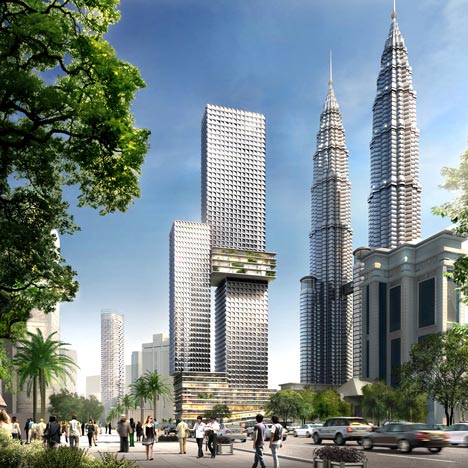
Angkasa Raya by Buro Ole Scheeren
Architect Ole Scheeren has designed a skyscraper for Kuala Lumpur that will have a four-storey-high tropical garden slicing through its middle.
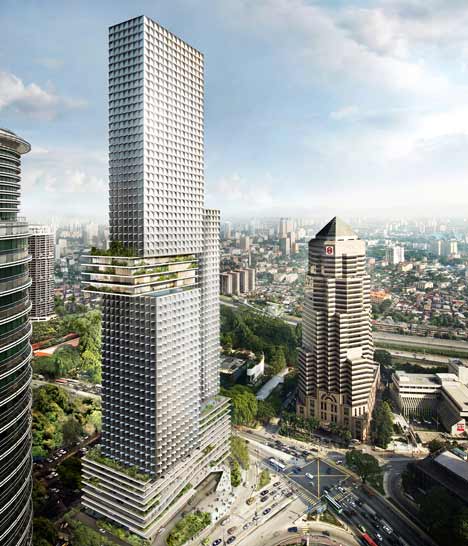
The Angkasa Raya tower will be 268 metres high and is to be situated alongside the Petronas Twin Towers, which were the tallest buildings in the world between 1998 and 2004.
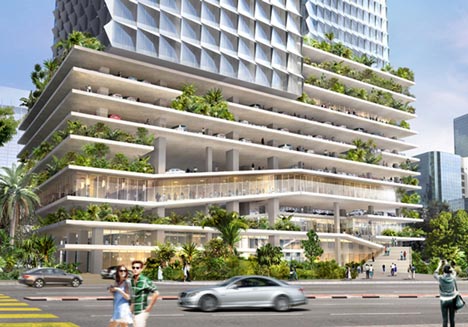
A restaurant, bar and infinity swimming pool will be nestled amongst the garden floors, while 280 apartments will occupy the storeys above.
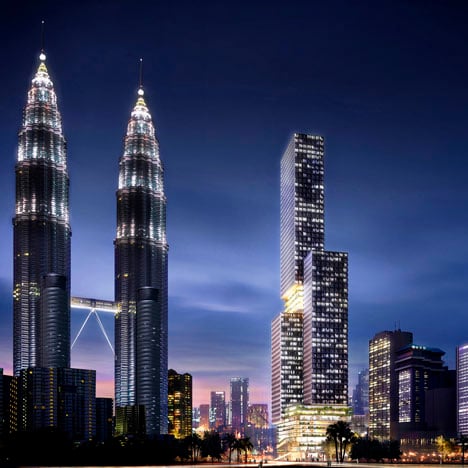
The lower levels of the building will house shops, cafes, car parks and prayer rooms.
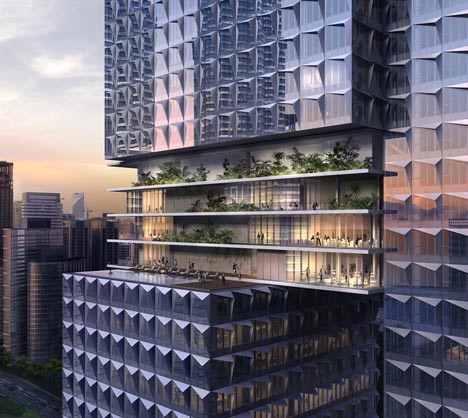
A luxury hotel will be located inside a smaller adjoining block.
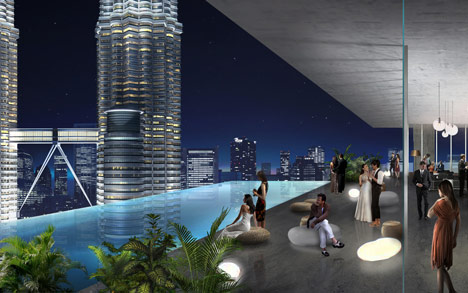
Construction is due to begin at the start of 2012.
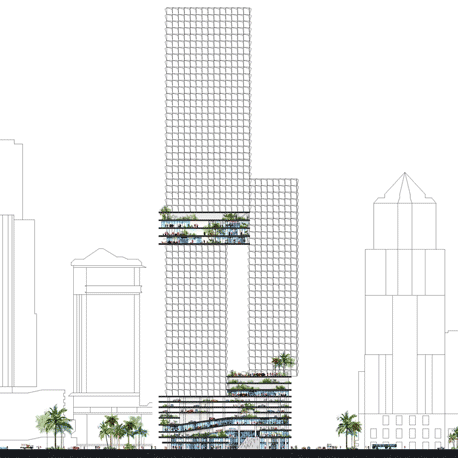
Ole Scheeren was formerly a partner at OMA, where he led the design of the China Central Television Station in Beijing, but left in 2010 to start his own firm – see our earlier Dezeen Wire.
Here's a description of the project from Buro Ole Scheeren:
Ole Scheeren to build landmark tower in Kuala Lumpur
Ole Scheeren, the architect behind one of the most iconic buildings of the 21st century, the CCTV headquarters in Beijing, today revealed his design for a new landmark tower in the heart of Kuala Lumpur. The 268 meter tall tower, Angkasa Raya, was unveiled today at an official ceremony in the capital, and will stand as a symbol of Malaysia’s diverse and multi-cultural society.
In 1998, Kuala Lumpur made world news for constructing the tallest skyscrapers in the world – the Petronas Twin Towers. Today, Malaysia will once again appear on the world stage with a stunning new piece of architecture that alters the perception of what a skyscraper can be and how it connects to the city by inviting life into its balancing heights and visually projecting it back into the urban landscape.
Commissioned by leading Malaysian property developer Sunrise Berhad (a member of UEM Land Holdings Berhad), the new tower will stand directly across the Petronas, offering new architectural qualities to the vibrancy of the city’s inner core. Rather than a single mass, Angkasa Raya is made up of three cubic volumes which appear to float above open, horizontal layers. The “ground levels” form an interconnected spiral of both pedestrian and vehicular circulation and draw the diversity of the streetscape into the building. A multitude of public spaces and activities including shops, a food court, car parks, terraces and prayer rooms bring urban life into the transparent stacks, while tropical nature invades and enlivens its multiple levels.
A second stack of horizontal slabs is lifted up in the air and hovers above the city. These “sky levels” contain a restaurant, bar, and multi-function spaces amid lush vegetation, giving the public access to one of the city’s most breathtaking views across its skyline and the neighboring Twin Towers. The three floating blocks accommodate the high-end Service Residences, a Luxury Hotel and Premium Offices.
Angkasa Raya demonstrates possibilities for the amplification of life and activities within the heart of one of Asia’s great capitals. Lush green gardens and terraces offer intimacies within the extreme urban density of the surrounding metropolis, while carefully shaded facades and a naturally ventilated atrium underline the environmental responsibility of the design.
With demolition of the existing building on the site completed in August 2011, construction is set to begin in the first quarter of 2012.
Angkasa Raya Project Description
Angkasa Raya, situated in Malaysia’s capital at the intersection of Jalan Ampang and Jalan P. Ramlee, directly across the well-known Petronas Twin Towers in the heart of Kuala Lumpur City Centre (KLCC), presents a new typology in high-rise skyscraper design that overtly expresses the inhabitation of diverse urban activities in a tropical environment and captures the vibrancy of the city’s multifaceted culture.
Angkasa Raya is comprised of five distinct elements – three floating elevated tower blocks and two multi-level zones of open horizontal slabs – that are autonomous yet connected to one another in a uniquely stacked and shifting configuration of varied functional and urban typologies. Rather than competing with the Twin Towers in the form of another “twin” or blending into the surrounding context of singular towers on a podium, Angkasa Raya offers a new contemporary reading of the capital city and stands as an icon of the harmonious and dynamic balance of Malaysia’s cultural multiplicity and diversity.
At a height of 268 meters over 65 floors, and 165,000 square meters of construction area, Angkasa Raya accommodates Premium Offices, a Luxury Hotel and Service Residences. Each function occupies one of the three rectangular volumes which, through their mutual support and delicate balance, generate a unity that is both multiple and symbiotic.
The “Ground Levels”, a series of open horizontal slabs, bring urban life into the building and unfold two interconnected spirals of vehicular and pedestrian circulation, mixing signature retail, restaurants/cafes, a food court, and prayer rooms with abundant outdoor greenery and urban streetscape.The plural trajectories weave through the open levels and offer multiple street-like experiences of interconnected activities. A grand staircase welcomes the public to the second floor of the Ground Levels and provides an amphitheatre-like seating area with views towards the Petronas Twin Towers and Suria KLCC.
Moving beyond the typical model of inert multi-level parking podiums, the open framework of the Ground Levels introduces and extends the coexistence of urban activities and injects exciting public spaces into the heart of the building. While multi-story parking podiums are typically seen as an urban blight, this integrated model of multi-use indoor-outdoor activity fuses multicultural programs into a system of civic inclusivity and public accessibility.
At the virtual intersection between the three tower blocks, 120 meters above the city, are four levels of tropical greenery and metropolitan activity: the Sky Levels. Catapulting the public energy of the Ground Levels skywards, a signature bar and restaurant with outdoor dining terraces, an infinity edge pool, as well as a multi-function banquet hall, business lounges and meeting rooms offer premium work and leisure space in a lush environment with spectacular elevated views of the dramatic skyline.
The Service Residences, a family of high-end condominiums, are located in the upper tower block from floor 37 to 64and grouped around a naturally ventilated atrium. Over 280 units of studios, one to three bedroom apartments and duplexes, as well as penthouses benefit from the stunning views of the surrounding cityscape.
The luxury Hotel occupies the smaller tower volume facing Jalan Ampang. With more than 200 suites of varying sizes, a distinct type of short-term city dwelling complements Angkasa Raya’s offerings.
The Premium Offices in the lowest and largest tower block provide flexible floor space facing the Petronas Twin Towers at one of the city’s most prestigious addresses.
The carefully calibrated offsetting of the tower volumes with the Ground and Sky Levels creates a series of outdoor landscape and activity terraces that provide numerous moments of tropicality that punctuate Angkasa Raya in the form of lush vegetation, thereby maximizing the amount of green areas within the dense site. Hotel guests will enjoy dedicated amenities including a business center, club lounge and café, fitness center, and outdoor lap pool. The Service Residences are likewise equipped with its own set of dedicated facilities on top of the Sky Levels – lap pool, Jacuzzi, Children’s pool, gym, and an expansive landscaped garden.
The tower façades are clad with modular aluminum sun-shading, geometrically optimized and carefully oriented to reduce solar heat gain under the intense tropical sun, and contribute to substantial energy savings through passive means. Other environmental features include a naturally ventilated atrium within the Residences Tower, eliminating the need for air conditioning and recirculation. By connecting the atrium through a series of large- scale voids to the building envelope, natural daylight is provided throughout the vertical space while communal seating areas and tropical lounges are created within the atrium. Rainwater harvesting, landscape re-irrigation, insulated green roofs, and the natural shading effects of the horizontal slabs of the Ground and Sky Levels effectively reduce the energy and water consumption and optimize the carbon footprint of the building.